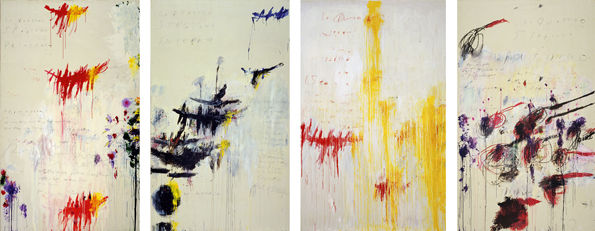Cy Twombly: A Life with Lines and Scribbles
- ONOTABI Editorial Team

- 19 nov 2024
- 4 minuten om te lezen
Bijgewerkt op: 24 dec 2024
Cy Twombly (1928–2011) stands as a seminal figure in 20th-century art, renowned for his distinctive fusion of abstraction, calligraphy, and classical references. His oeuvre, characterized by gestural marks, scribbles, and textual elements, bridges the gap between Abstract Expressionism and a deeply personal exploration of history and mythology. This essay delves into Twombly's artistic development and provides an extensive analysis of his work, underscoring his enduring influence on contemporary art.

Source: Brittanica
Early Life and Education
Edwin Parker "Cy" Twombly Jr. was born on April 25, 1928, in Lexington, Virginia. His father, a coach and athletic director at Washington and Lee University, nicknamed him "Cy" after the renowned baseball pitcher Cy Young. Twombly's early exposure to art was facilitated by his parents, who encouraged his creative pursuits. Twombly's formal art education commenced at the School of the Museum of Fine Arts in Boston (1947–1949), followed by studies at Washington and Lee University. In 1950, he attended the Art Students League in New York, where he met Robert Rauschenberg, a fellow artist who would become a significant influence and collaborator. Subsequently, Twombly enrolled at Black Mountain College in North Carolina, an institution known for its avant-garde approach and distinguished faculty, including Josef Albers and Franz Kline. This eclectic educational background provided Twombly with a solid foundation in both traditional techniques and avant-garde theories.
Artistic Development
Twombly's early works in the 1950s were influenced by Abstract Expressionism, characterized by gestural brushwork and an emphasis on spontaneity. However, he soon began to diverge from the movement's conventions, incorporating elements of writing, symbols, and references to classical antiquity into his compositions. This integration of text and image became a hallmark of his style, setting him apart from his contemporaries.
A pivotal moment in Twombly's development occurred during a trip to North Africa and Europe with Rauschenberg in 1952–1953. The journey exposed him to diverse cultures and histories, profoundly impacting his artistic vision. Upon returning to the United States, Twombly served in the U.S. Army as a cryptologist, an experience that further deepened his interest in codes, symbols, and the written form.
In 1957, Twombly relocated to Rome, Italy, a move that would significantly influence his work. Immersed in the rich tapestry of Mediterranean history, art, and mythology, he began to infuse his paintings with references to classical literature and ancient cultures. This period marked a departure from the New York art scene and allowed Twombly to cultivate a unique artistic language that blended abstraction with historical narrative.
Analysis of Major Works
Twombly's oeuvre is vast and varied, but several key works exemplify his innovative approach and thematic concerns.
"Leda and the Swan" (1962)
This painting draws upon the Greek myth of Leda and Zeus, who transformed into a swan. Twombly's rendition is a tumultuous composition of swirling lines, smudges, and scribbles, evoking the violent and erotic nature of the myth. The chaotic energy of the piece reflects the intensity of the narrative, while the abstract forms allow for multiple interpretations.
"Nine Discourses on Commodus" (1963)
Comprising a series of nine paintings, this work references the Roman Emperor Commodus. The series progresses from light to dark, symbolizing the descent into madness and chaos associated with Commodus's reign. Twombly employs a palette of reds, blacks, and whites, with aggressive brushstrokes and drips, conveying a sense of violence and decay.
"Untitled (Bacchus)" Series (2005)
In this later series, Twombly revisits the theme of Bacchus, the Roman god of wine and ecstasy. The paintings are characterized by looping, gestural lines in deep reds against neutral backgrounds, evoking the movement of wine and the frenzied energy of Bacchic rituals. The fluidity and dynamism of the lines reflect Twombly's continued exploration of motion and emotion through abstraction.
"Quattro Stagioni" (1993–1995)
Translated as "The Four Seasons," this series comprises four large-scale paintings, each representing a different season. Twombly combines vibrant colors with scribbled text, referencing poetry and classical literature associated with each season. The series reflects on the passage of time, the cycles of nature, and the interplay between life and death.

Quattro Stagioni - Cy Twombly
Themes and Techniques
Twombly's work is distinguished by several recurring themes and techniques:
Integration of Text and Image: Twombly frequently incorporated words, phrases, and quotations into his paintings, blurring the line between writing and visual art. These textual elements often reference classical literature, poetry, and mythology, adding layers of meaning and inviting viewers to engage with the work on both a visual and intellectual level.
Gestural Abstraction: His use of spontaneous, gestural marks—scribbles, drips, and smudges—creates a sense of immediacy and raw emotion. This technique aligns with the principles of Abstract Expressionism but is uniquely infused with personal and historical references.
Classical References: Twombly's deep engagement with classical antiquity is evident throughout his oeuvre. By referencing myths, historical figures, and ancient texts, he bridges the past and present, exploring timeless human experiences and emotions.
Color and Texture: His palette ranges from muted, earthy tones to vibrant, saturated colors. Twombly often layered paint to create rich textures, adding depth and complexity to his compositions.
Legacy and Influence
Twombly's innovative fusion of abstraction, text, and historical reference has left an indelible mark on contemporary art. His work challenges traditional distinctions between painting and writing, abstraction and figuration, inviting viewers to engage with art as a multifaceted experience. Twombly's



Opmerkingen